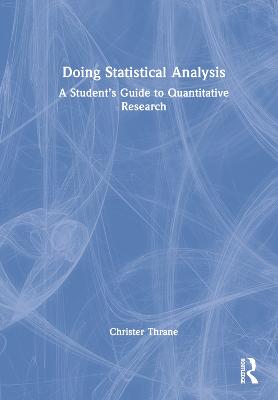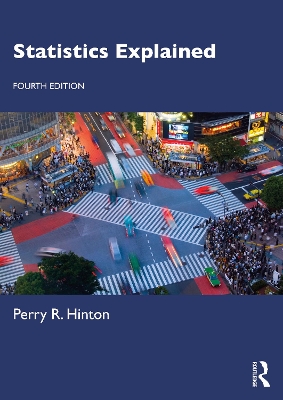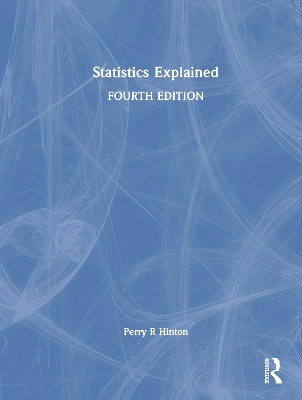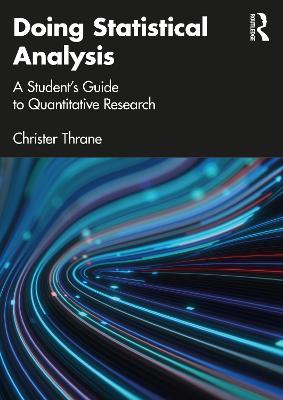Doing Statistical Analysis
 portes grátis
portes grátis
Doing Statistical Analysis
A Student's Guide to Quantitative Research
Thrane, Christer
Taylor & Francis Ltd
07/2022
256
Dura
Inglês
9781032180304
15 a 20 dias
453
Descrição não disponível.
Acknowledgments
1. What is statistical analysis from a research perspective?
1.1 A statistical association: Covid-19 spread and residential property prices
1.2 Why do statistical analysis in research? The book's purpose and pedagogical approach
1.3 Three types of statistical research questions: Descriptive, associational, and inferential
1.4 Some key concepts you really should understand
1.5 Chapter summary, key learning points, and the organization of the rest of the book
2. Descriptive research questions
2.1 Introduction and chapter overview
2.2 What is typical? Three measures of central tendency: Mean, median, and mode
2.3 Variables' measurement levels: Continuous or categorical variables
2.4 Ordinal variables: A third and special-case measurement level
2.5 Visual presentation of descriptive statistics: Graphs
2.6 The concept of variation: Statistical spread for continuous variables
2.7 Foreshadowing associational research questions: Descriptive statistics for subgroups
2.8 Chapter summary, key learning points, and further reading
2.9 Executing statistical commands: do-files in Stata and syntax-files in SPSS
2.10 Chapter exercises with solutions
Appendix A: Christmas beer data
Appendix B: Soccer data
Appendix C: Student exercise data
3. Associational research questions I: Bivariate analysis
3.1 Introduction: The association between two variables, x and y
3.2 A categorical x and a categorical y: Cross-tabulation
3.3 A categorical x and a continuous y: ANOVA
3.4 A continuous x and a continuous y: Regression analysis
3.5 An ordinal y and bivariate analysis
3.6 The limitations of bivariate analysis: The need for statistical control for a third variable
3.7 Experimental control for a third (and fourth) variable
3.8 Chapter summary, key learning points, and further reading
3.9 Do-files in Stata and syntax-files in SPSS
3.10 Chapter exercises with solutions
4. Associational research questions II: Multiple regression
4.1 Introduction and chapter overview
4.2 Statistical control for observational data: Two examples
4.3 The multiple regression model and R2
4.4 Non-linear effects
4.5 Interaction effects (moderator effects)
4.6 Regression on experimental data
4.7 A dummy y
4.8 Chapter summary, key learning points, and further reading
4.9 Do-files in Stata and syntax-files in SPSS
4.10 Chapter exercises with solutions
Appendix A: Student exercise motive data
Appendix B: Student tourism data
Appendix C: Red wine data
5. Inferential research questions
5.1 Introduction and chapter overview
5.2 Samples, populations, and random sampling
5.3 Repeated sampling and the normal distribution
5.4 The 95 percent CI for descriptive statistics: Means and proportions
5.5 The 95 percent CI for variable associations
5.6 Verifying that random sampling and the Central Limit Theorem work as promised
5.7 Hypothesis testing and the assessment of statistical significance
5.8 Critical aspects of significance testing
5.9 Chapter summary, key learning points, and further reading
5.10 Do-files in Stata and syntax-files in SPSS
5.11 Chapter exercises with solutions
6. Doing quantitative research: Some tricks of the trade
6.1 Introduction and chapter overview
6.2 Creating, recoding, and labeling new variables
6.3 Creating a new variable by combining existing variables
6.4 Missing data and what to do about them
6.5 Outliers: When too much information causes trouble
6.6 The assumptions of regression analysis
6.7 Effect sizes
6.8 How to present and communicate statistical-association results
6.9 Chapter summary, key learning points, and further reading
6.10 Statistical commands: Do-files in Stata and syntax-files in SPSS
6.11 Chapter exercises with solutions
Appendix A: Female student weight data
References
Index
1. What is statistical analysis from a research perspective?
1.1 A statistical association: Covid-19 spread and residential property prices
1.2 Why do statistical analysis in research? The book's purpose and pedagogical approach
1.3 Three types of statistical research questions: Descriptive, associational, and inferential
1.4 Some key concepts you really should understand
1.5 Chapter summary, key learning points, and the organization of the rest of the book
2. Descriptive research questions
2.1 Introduction and chapter overview
2.2 What is typical? Three measures of central tendency: Mean, median, and mode
2.3 Variables' measurement levels: Continuous or categorical variables
2.4 Ordinal variables: A third and special-case measurement level
2.5 Visual presentation of descriptive statistics: Graphs
2.6 The concept of variation: Statistical spread for continuous variables
2.7 Foreshadowing associational research questions: Descriptive statistics for subgroups
2.8 Chapter summary, key learning points, and further reading
2.9 Executing statistical commands: do-files in Stata and syntax-files in SPSS
2.10 Chapter exercises with solutions
Appendix A: Christmas beer data
Appendix B: Soccer data
Appendix C: Student exercise data
3. Associational research questions I: Bivariate analysis
3.1 Introduction: The association between two variables, x and y
3.2 A categorical x and a categorical y: Cross-tabulation
3.3 A categorical x and a continuous y: ANOVA
3.4 A continuous x and a continuous y: Regression analysis
3.5 An ordinal y and bivariate analysis
3.6 The limitations of bivariate analysis: The need for statistical control for a third variable
3.7 Experimental control for a third (and fourth) variable
3.8 Chapter summary, key learning points, and further reading
3.9 Do-files in Stata and syntax-files in SPSS
3.10 Chapter exercises with solutions
4. Associational research questions II: Multiple regression
4.1 Introduction and chapter overview
4.2 Statistical control for observational data: Two examples
4.3 The multiple regression model and R2
4.4 Non-linear effects
4.5 Interaction effects (moderator effects)
4.6 Regression on experimental data
4.7 A dummy y
4.8 Chapter summary, key learning points, and further reading
4.9 Do-files in Stata and syntax-files in SPSS
4.10 Chapter exercises with solutions
Appendix A: Student exercise motive data
Appendix B: Student tourism data
Appendix C: Red wine data
5. Inferential research questions
5.1 Introduction and chapter overview
5.2 Samples, populations, and random sampling
5.3 Repeated sampling and the normal distribution
5.4 The 95 percent CI for descriptive statistics: Means and proportions
5.5 The 95 percent CI for variable associations
5.6 Verifying that random sampling and the Central Limit Theorem work as promised
5.7 Hypothesis testing and the assessment of statistical significance
5.8 Critical aspects of significance testing
5.9 Chapter summary, key learning points, and further reading
5.10 Do-files in Stata and syntax-files in SPSS
5.11 Chapter exercises with solutions
6. Doing quantitative research: Some tricks of the trade
6.1 Introduction and chapter overview
6.2 Creating, recoding, and labeling new variables
6.3 Creating a new variable by combining existing variables
6.4 Missing data and what to do about them
6.5 Outliers: When too much information causes trouble
6.6 The assumptions of regression analysis
6.7 Effect sizes
6.8 How to present and communicate statistical-association results
6.9 Chapter summary, key learning points, and further reading
6.10 Statistical commands: Do-files in Stata and syntax-files in SPSS
6.11 Chapter exercises with solutions
Appendix A: Female student weight data
References
Index
Este título pertence ao(s) assunto(s) indicados(s). Para ver outros títulos clique no assunto desejado.
Doing;Statistical;Analysis;Thrane;Perspective;Research;STATISTICS COEFF OUTS;Quantitative Research;Exercise Hours;Data Set;Regression Coefficient;Regression Model;Sports Club Members;COUNT ROUND CELL;Exercise Motivation;Fitness Center;Regression Line;Kernel Density Plot;Trip Destination;Missing Values;Summary Descriptive Statistics;Null Hypothesis;National Team Players;Quantitative Research Process;Taste Quality;Tab Command;National Team;Bottle Price;Percent Significance Level;Influential Outliers;Sports Club Membership
Acknowledgments
1. What is statistical analysis from a research perspective?
1.1 A statistical association: Covid-19 spread and residential property prices
1.2 Why do statistical analysis in research? The book's purpose and pedagogical approach
1.3 Three types of statistical research questions: Descriptive, associational, and inferential
1.4 Some key concepts you really should understand
1.5 Chapter summary, key learning points, and the organization of the rest of the book
2. Descriptive research questions
2.1 Introduction and chapter overview
2.2 What is typical? Three measures of central tendency: Mean, median, and mode
2.3 Variables' measurement levels: Continuous or categorical variables
2.4 Ordinal variables: A third and special-case measurement level
2.5 Visual presentation of descriptive statistics: Graphs
2.6 The concept of variation: Statistical spread for continuous variables
2.7 Foreshadowing associational research questions: Descriptive statistics for subgroups
2.8 Chapter summary, key learning points, and further reading
2.9 Executing statistical commands: do-files in Stata and syntax-files in SPSS
2.10 Chapter exercises with solutions
Appendix A: Christmas beer data
Appendix B: Soccer data
Appendix C: Student exercise data
3. Associational research questions I: Bivariate analysis
3.1 Introduction: The association between two variables, x and y
3.2 A categorical x and a categorical y: Cross-tabulation
3.3 A categorical x and a continuous y: ANOVA
3.4 A continuous x and a continuous y: Regression analysis
3.5 An ordinal y and bivariate analysis
3.6 The limitations of bivariate analysis: The need for statistical control for a third variable
3.7 Experimental control for a third (and fourth) variable
3.8 Chapter summary, key learning points, and further reading
3.9 Do-files in Stata and syntax-files in SPSS
3.10 Chapter exercises with solutions
4. Associational research questions II: Multiple regression
4.1 Introduction and chapter overview
4.2 Statistical control for observational data: Two examples
4.3 The multiple regression model and R2
4.4 Non-linear effects
4.5 Interaction effects (moderator effects)
4.6 Regression on experimental data
4.7 A dummy y
4.8 Chapter summary, key learning points, and further reading
4.9 Do-files in Stata and syntax-files in SPSS
4.10 Chapter exercises with solutions
Appendix A: Student exercise motive data
Appendix B: Student tourism data
Appendix C: Red wine data
5. Inferential research questions
5.1 Introduction and chapter overview
5.2 Samples, populations, and random sampling
5.3 Repeated sampling and the normal distribution
5.4 The 95 percent CI for descriptive statistics: Means and proportions
5.5 The 95 percent CI for variable associations
5.6 Verifying that random sampling and the Central Limit Theorem work as promised
5.7 Hypothesis testing and the assessment of statistical significance
5.8 Critical aspects of significance testing
5.9 Chapter summary, key learning points, and further reading
5.10 Do-files in Stata and syntax-files in SPSS
5.11 Chapter exercises with solutions
6. Doing quantitative research: Some tricks of the trade
6.1 Introduction and chapter overview
6.2 Creating, recoding, and labeling new variables
6.3 Creating a new variable by combining existing variables
6.4 Missing data and what to do about them
6.5 Outliers: When too much information causes trouble
6.6 The assumptions of regression analysis
6.7 Effect sizes
6.8 How to present and communicate statistical-association results
6.9 Chapter summary, key learning points, and further reading
6.10 Statistical commands: Do-files in Stata and syntax-files in SPSS
6.11 Chapter exercises with solutions
Appendix A: Female student weight data
References
Index
1. What is statistical analysis from a research perspective?
1.1 A statistical association: Covid-19 spread and residential property prices
1.2 Why do statistical analysis in research? The book's purpose and pedagogical approach
1.3 Three types of statistical research questions: Descriptive, associational, and inferential
1.4 Some key concepts you really should understand
1.5 Chapter summary, key learning points, and the organization of the rest of the book
2. Descriptive research questions
2.1 Introduction and chapter overview
2.2 What is typical? Three measures of central tendency: Mean, median, and mode
2.3 Variables' measurement levels: Continuous or categorical variables
2.4 Ordinal variables: A third and special-case measurement level
2.5 Visual presentation of descriptive statistics: Graphs
2.6 The concept of variation: Statistical spread for continuous variables
2.7 Foreshadowing associational research questions: Descriptive statistics for subgroups
2.8 Chapter summary, key learning points, and further reading
2.9 Executing statistical commands: do-files in Stata and syntax-files in SPSS
2.10 Chapter exercises with solutions
Appendix A: Christmas beer data
Appendix B: Soccer data
Appendix C: Student exercise data
3. Associational research questions I: Bivariate analysis
3.1 Introduction: The association between two variables, x and y
3.2 A categorical x and a categorical y: Cross-tabulation
3.3 A categorical x and a continuous y: ANOVA
3.4 A continuous x and a continuous y: Regression analysis
3.5 An ordinal y and bivariate analysis
3.6 The limitations of bivariate analysis: The need for statistical control for a third variable
3.7 Experimental control for a third (and fourth) variable
3.8 Chapter summary, key learning points, and further reading
3.9 Do-files in Stata and syntax-files in SPSS
3.10 Chapter exercises with solutions
4. Associational research questions II: Multiple regression
4.1 Introduction and chapter overview
4.2 Statistical control for observational data: Two examples
4.3 The multiple regression model and R2
4.4 Non-linear effects
4.5 Interaction effects (moderator effects)
4.6 Regression on experimental data
4.7 A dummy y
4.8 Chapter summary, key learning points, and further reading
4.9 Do-files in Stata and syntax-files in SPSS
4.10 Chapter exercises with solutions
Appendix A: Student exercise motive data
Appendix B: Student tourism data
Appendix C: Red wine data
5. Inferential research questions
5.1 Introduction and chapter overview
5.2 Samples, populations, and random sampling
5.3 Repeated sampling and the normal distribution
5.4 The 95 percent CI for descriptive statistics: Means and proportions
5.5 The 95 percent CI for variable associations
5.6 Verifying that random sampling and the Central Limit Theorem work as promised
5.7 Hypothesis testing and the assessment of statistical significance
5.8 Critical aspects of significance testing
5.9 Chapter summary, key learning points, and further reading
5.10 Do-files in Stata and syntax-files in SPSS
5.11 Chapter exercises with solutions
6. Doing quantitative research: Some tricks of the trade
6.1 Introduction and chapter overview
6.2 Creating, recoding, and labeling new variables
6.3 Creating a new variable by combining existing variables
6.4 Missing data and what to do about them
6.5 Outliers: When too much information causes trouble
6.6 The assumptions of regression analysis
6.7 Effect sizes
6.8 How to present and communicate statistical-association results
6.9 Chapter summary, key learning points, and further reading
6.10 Statistical commands: Do-files in Stata and syntax-files in SPSS
6.11 Chapter exercises with solutions
Appendix A: Female student weight data
References
Index
Este título pertence ao(s) assunto(s) indicados(s). Para ver outros títulos clique no assunto desejado.
Doing;Statistical;Analysis;Thrane;Perspective;Research;STATISTICS COEFF OUTS;Quantitative Research;Exercise Hours;Data Set;Regression Coefficient;Regression Model;Sports Club Members;COUNT ROUND CELL;Exercise Motivation;Fitness Center;Regression Line;Kernel Density Plot;Trip Destination;Missing Values;Summary Descriptive Statistics;Null Hypothesis;National Team Players;Quantitative Research Process;Taste Quality;Tab Command;National Team;Bottle Price;Percent Significance Level;Influential Outliers;Sports Club Membership







